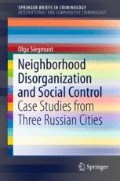Abstract
Parental supervision was measured by six items that build two factors: the first factor measures the interest that parents have in the leisure activities of their children (sympathy and interest) and the second factor measures the parents’ knowledge of how their children spend their leisure time. The attachment to the parents was measured based on two items that also include two facets of attachment: the subjective quality of the attachment to their fathers and mothers from the students’ point of view and the importance of the parental opinion on the students themselves. Self-control was tested with a short version of the self-control scale by Grasmick et al. (1993). As an overall measure of delinquency, versatility was built from the prevalence of 12 delinquency variables (damage to property, graffiti spraying, shoplifting, theft from persons, burglary, theft from vehicles, vehicle heft, assault with and without a weapon, threat with a weapon, robbery, and extortion).
Access this chapter
Tax calculation will be finalised at checkout
Purchases are for personal use only
Notes
- 1.
The answer categories ranged from 1 = “not correct at all” to 4 = “totally correct”.
- 2.
(1) My parents are very interested in what I do in my leisure time. (2) I think my parents do not care about what I do in my leisure time. (3) My parents ask me often which young people I meet.
- 3.
(1) My parents know all my friends. (2) My parents know my friend’s parents. (3) My parents know nearly ever where I am in my leisure time.
- 4.
How good are you getting along with your father/stepfather (your mother/stepmother)? There are four answer possibilities: 1 = “not good at all”, 2 = “not really good”, 3 = “passably good”, and 4 = “really good”.
- 5.
How important to you is your parents’ opinion about you? The answer possibilities ranged from 1 = “totally unimportant” over 2 = “unimportant”, 3 = “rather unimportant”, 4 = “rather important”, and 5 = “important” to 6 = “really important”.
- 6.
(1) Sometimes, I will take a risk just for the fun of it. (2) Excitement and adventure are more important to me than security. (3) I like to test myself every now and then by doing something a little risky.
- 7.
(1) I am more concerned with what happens to me in the short run than in the long run. (2) I often act on the spur of the moment without stopping to think. (3) I often do whatever brings me pleasure here and now even at the cost of some distant goal.
- 8.
(1) I will try to get the things I want even when I know it is causing problems for other people. (2) I try to look out for myself first even if it means making things difficult for other people. (3) If things I do upset people, it is their problem not mine.
- 9.
Did you already (1) steal something in a shop or store; (2) bash and hurt another person; (3) break open a car to steal something (or participate in this); (4) threat another person with a weapon; (5) spray graffiti on an illegal place; (6) damage intentionally a window, a phone box, streetlight, or similar objects; (7) steal a bicycle, a moped, or another vehicle; (8) extort someone, alone or with other people, and this person pays to not be battered; (9) take something from someone mightily, alone or with other people; (10) burgle something to steal (e.g., a construction trailer, an arbor, and a basement); (11) hurt someone with a weapon (knobkerrie or knife); or (12) steal covert money, a bag, or something else from another person?
Reference
Grasmick, H. G., Tittle, C. R., Bursik, R. J., & Arneklev, B. J. (1993). Testing the core empirical implications of Gottfredson and Hirschi’s general theory of crime. Journal of Research in Crime and Delinquency, 30, 5–29.
Author information
Authors and Affiliations
Corresponding author
Rights and permissions
Copyright information
© 2016 The Author(s)
About this chapter
Cite this chapter
Siegmunt, O. (2016). Descriptive Results and Scale Analysis: Individual-Level Variables. In: Neighborhood Disorganization and Social Control. SpringerBriefs in Criminology(). Springer, Cham. https://doi.org/10.1007/978-3-319-21590-7_8
Download citation
DOI: https://doi.org/10.1007/978-3-319-21590-7_8
Published:
Publisher Name: Springer, Cham
Print ISBN: 978-3-319-21589-1
Online ISBN: 978-3-319-21590-7
eBook Packages: Law and CriminologyLaw and Criminology (R0)

